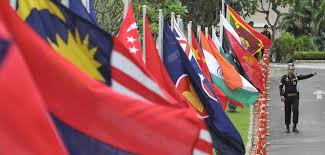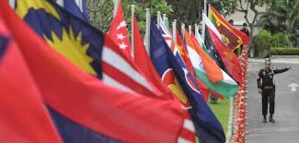The interest shown by the United States administration under President Donald Trump for Southeast Asia is typically viewed as counter strategy to the dominance of the China on the region. While the influence of China over the region would likely be a part of the agenda during the slated visit of Secretary of State Mike Pompeo’s visit top the region, there would be other important issues dominating meetings with the leaders of the region.
It is expected that Pompeo would provide details of the $113 million infrastructure fund announced by the US for the Asia a few days back aimed for the Asia-Pacific economies, during his meetings with the leaders of Malaysia Singapore and Indonesia.
The visit assumes importance because there is some deep rooted skepticism about Washington’s policies for South east Asia.
For many countries, one of the major focus is the pressure being exerted by the US on countries to reduce the trade deficit. For example, warning about the trade barriers in Jakarta was issued in April by the U.S. Trade Representative. Others are concern ed about US military footprint in foreign countries.
Michael Mazza, visiting fellow in foreign and defense policy studies at the American Enterprise Institute, said Pompeo's trip "is crucial to advancing American interests in a region where showing up is half the battle."
Some South East Asian countries are also worried about the concept of the US about a “free and open” Indo-Pacific region.
Joshua Kurlantzick, senior fellow for Southeast Asia at the Council on Foreign Relations, said in a note: "Several have worried that the Trump administration could force countries in the region to choose openly between Washington and Beijing, a move that they say would backfire."
Despite the fact that a number of countries in the Southeast Asian region are concerned about the rising investments of China in the area, its trade practices and its activities in the South China Sea, the degree to which those countries would openly come up to criticize these concerns remains to be seen and whether they would accept the US Indo-Pacific strategy said Kurlantzick.
Warnings about the danger for Asian countries of being forced to choose between the US and China have been repeatedly issued by Singapore Prime Minister Lee Hsien Loong.
Mazza said the countries in the region would be waiting to know the exact role that the US envisions in its Indo-Pacific strategy.
"Hopefully, Secretary Pompeo will use his travels this week as an opportunity to begin laying out a comprehensive American strategy for Southeast Asia — explaining why it matters, what U.S. goals are, and how the United States will work to achieve them," he added.
The hot topics of debate these days in South east Asia is democracy and rights especially in eth light of the strongman policies of Philippine President Rodrigo Duterte and the crackdown in civil liberty by the newly re-elected Cambodian Prime Minister Hun Sen.
"Will Pompeo use the Free and Open Indo-Pacific concept to focus on rights and democracy regionally, or is a real focus on rights and democracy impossible given the White House's own focus on sovereignty and general de-emphasis of rights issues in U.S. policy?" said Kurlantzick.
(Source:www.cnbc.com)
It is expected that Pompeo would provide details of the $113 million infrastructure fund announced by the US for the Asia a few days back aimed for the Asia-Pacific economies, during his meetings with the leaders of Malaysia Singapore and Indonesia.
The visit assumes importance because there is some deep rooted skepticism about Washington’s policies for South east Asia.
For many countries, one of the major focus is the pressure being exerted by the US on countries to reduce the trade deficit. For example, warning about the trade barriers in Jakarta was issued in April by the U.S. Trade Representative. Others are concern ed about US military footprint in foreign countries.
Michael Mazza, visiting fellow in foreign and defense policy studies at the American Enterprise Institute, said Pompeo's trip "is crucial to advancing American interests in a region where showing up is half the battle."
Some South East Asian countries are also worried about the concept of the US about a “free and open” Indo-Pacific region.
Joshua Kurlantzick, senior fellow for Southeast Asia at the Council on Foreign Relations, said in a note: "Several have worried that the Trump administration could force countries in the region to choose openly between Washington and Beijing, a move that they say would backfire."
Despite the fact that a number of countries in the Southeast Asian region are concerned about the rising investments of China in the area, its trade practices and its activities in the South China Sea, the degree to which those countries would openly come up to criticize these concerns remains to be seen and whether they would accept the US Indo-Pacific strategy said Kurlantzick.
Warnings about the danger for Asian countries of being forced to choose between the US and China have been repeatedly issued by Singapore Prime Minister Lee Hsien Loong.
Mazza said the countries in the region would be waiting to know the exact role that the US envisions in its Indo-Pacific strategy.
"Hopefully, Secretary Pompeo will use his travels this week as an opportunity to begin laying out a comprehensive American strategy for Southeast Asia — explaining why it matters, what U.S. goals are, and how the United States will work to achieve them," he added.
The hot topics of debate these days in South east Asia is democracy and rights especially in eth light of the strongman policies of Philippine President Rodrigo Duterte and the crackdown in civil liberty by the newly re-elected Cambodian Prime Minister Hun Sen.
"Will Pompeo use the Free and Open Indo-Pacific concept to focus on rights and democracy regionally, or is a real focus on rights and democracy impossible given the White House's own focus on sovereignty and general de-emphasis of rights issues in U.S. policy?" said Kurlantzick.
(Source:www.cnbc.com)






